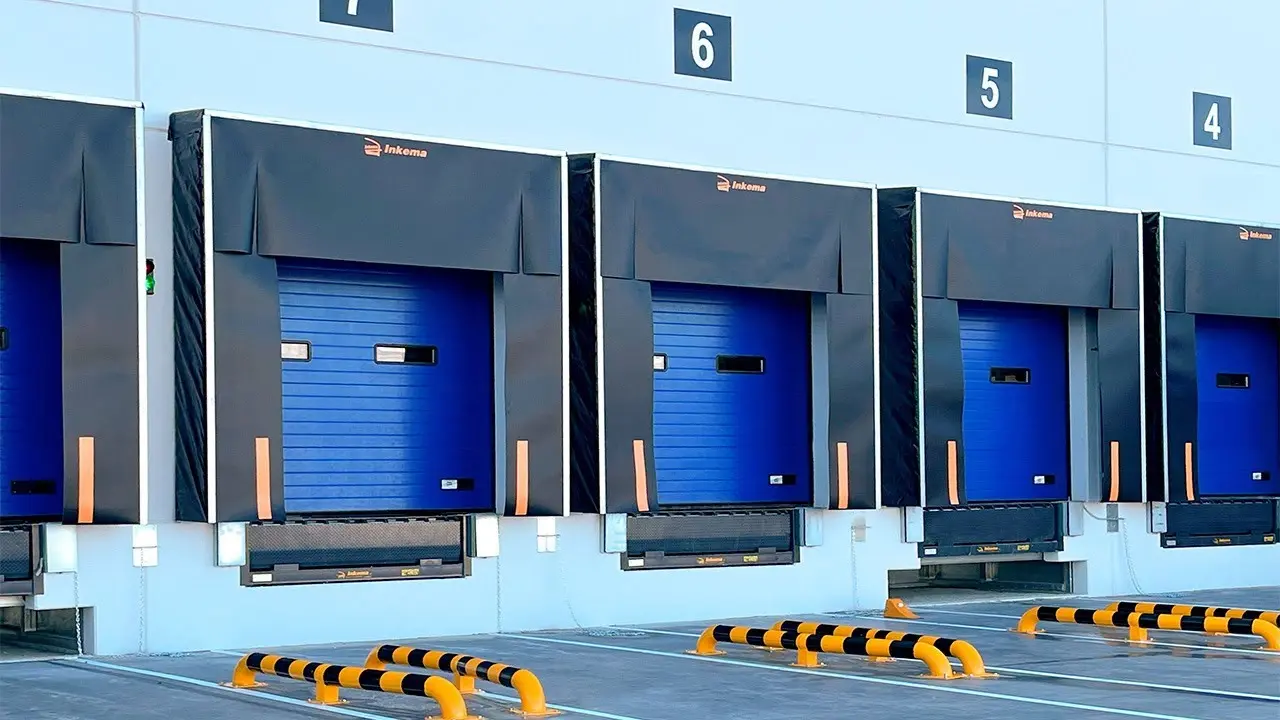Loading bay equipment plays a crucial role in optimizing efficiency and safety in warehouse and logistics operations. From dock levelers and shelters to wheel guides and control panels, these essential components work together to streamline the loading and unloading process, ensuring smooth transitions between vehicles and loading docks.
Key Equipment Overview
Loading bay equipment is essential for efficient and safe warehouse operations. Here’s a summary of key components and their functions:
- Dock Leveller: Bridge the gap between warehouse floors and vehicle beds, available in swing lip, telescopic, and edge of dock varieties.
- Dock Shelters and Seals: Provide weatherproofing and temperature control, improving energy efficiency.
- Wheel Guides: Ensure proper vehicle alignment with loading bays, reducing damage to equipment.
- Wheel Restraints: Clamp vehicle wheels to prevent accidental movement during loading/unloading.
- Dock Bumpers: Absorb impact from vehicles, protecting both the building and trucks.
- Safety Barriers and Guardrails: Prevent falls and restrict unauthorized access to loading areas.
- Lighting: LED dock lights illuminate vehicle interiors, while traffic lights indicate safe loading conditions.
- Control Panels: Centralize operation of various loading bay equipment.
- Mobile and Portable Loading Ramps: Provide versatile solutions for loading/unloading when permanent docks are unavailable.
- Adjustable Height Ramps: Accommodate vehicles of varying heights at a single loading point.
- Pedestrian Safety Barriers: Direct traffic and create safe zones for workers in loading areas.
Proper installation, regular maintenance, and adherence to safety protocols are crucial for maximizing the efficiency and longevity of loading bay equipment. By investing in the right combination of these components, businesses can streamline their logistics operations, enhance safety, and improve overall productivity in their loading bay areas.
Safety Barriers and Guardrails
Safety barriers and guardrails are essential components of loading bay equipment, designed to enhance workplace safety and prevent accidents. These protective structures include robust retractable gates that prevent accidental falls from the dock and restrict unauthorized access when the loading bay is not in use.
Loading bay barriers are typically made from durable materials like steel or aluminum, capable of withstanding significant impacts in industrial environments. They serve multiple purposes, including segregating work areas, protecting storage spaces from vehicle impacts, and acting as pallet stops for stored goods.
Some barriers are specifically designed for sub-zero environments, offering protection in cold storage facilities. By providing both physical deterrence and visual warnings, these safety systems contribute significantly to maintaining an efficient, secure, and accident-free loading area.
Mobile Loading Ramps
Mobile loading ramps, also known as yard ramps or container ramps, are versatile pieces of equipment designed to facilitate the loading and unloading of containers, trailers, and other vehicles when a permanent loading dock is unavailable. These ramps are typically constructed with a durable steel frame and feature an open grid deck for positive traction in all weather conditions.
They are equipped with hydraulic systems that allow for easy height adjustment, accommodating various vehicle heights and load requirements. Mobile ramps come in different capacities, with some models capable of supporting up to 15,000 kg, making them suitable for a wide range of industrial applications. Key features often include safety chains for securing the ramp to the container, side rails for added protection, and a swivel fork clamp attachment for easy maneuvering with a forklift.
These ramps significantly enhance operational efficiency by providing a safe and stable platform for forklifts and other machinery to access containers and vehicles, streamlining the logistics process in warehouses and distribution centers.
Dock Bumpers
Dock bumpers, also known as loading bay buffers, are essential protective devices installed on the edges of loading docks to absorb impact and prevent damage to both the building and vehicles during loading and unloading operations. These bumpers are typically made from durable materials such as rubber, nylon, or polyethylene, designed to withstand constant wear and tear in industrial environments.
They come in various types, including surface-mounted, recessed, corner, and heavy-duty bumpers, each tailored to specific loading dock requirements. By providing a cushion against impact, dock bumpers not only protect the structure and vehicles but also reduce the risk of accidents and injuries, ultimately extending the life of equipment and safeguarding investments in loading bay areas.
Dock Levelers
Dock levelers are essential components of loading bay equipment, designed to bridge the gap between the warehouse floor and vehicle beds of varying heights. These versatile devices come in several types, including swing lid, telescopic, and edge of dock levelers, each suited to different loading bay configurations and operational needs.
Swing lid dock levelers, such as the Dock Plus HDS 9000, are compliant with European regulations BSEN1398 and can be installed in new or existing loading bays. Telescopic dock levelers, like the Dock Plus HDT 8000, feature a horizontal safety lid that extends to connect with the vehicle, while edge of dock levelers offer a compact solution for areas where traditional systems cannot be mounted. These levelers are typically available in various capacities, with some models supporting up to 10,000 kg, ensuring safe and efficient loading operations across different industries.
Pedestrian Safety Barriers
Pedestrian safety barriers are crucial components in loading bay areas, designed to protect workers and visitors from potential hazards. These barriers, often made from durable materials like steel or high-density polyethylene, serve multiple purposes including directing traffic, preventing accidental falls, and creating designated safe zones.
They can be customized to fit specific loading bay dimensions and are available in various configurations such as fixed, retractable, or expandable systems. Highly visible in bright colors, these barriers not only enhance safety but also help comply with health and safety regulations. Some advanced designs feature crumple-friendly technology, which reduces the severity of impact in case of collisions. By clearly marking potentially dangerous areas and controlling pedestrian movement, these barriers significantly reduce the risk of accidents and contribute to a safer, more organized loading bay environment.
Adjustable Height Ramps
Adjustable height ramps are versatile loading dock solutions that enable facilities to accommodate vehicles of varying heights at a single loading point. These hydraulic ramps, such as Dockzilla’s patented “Z-Deck” universal truck leveler, allow for easy push-button operation to adjust the ramp height, eliminating the need for additional docks.
They can safely service a range of vehicles, from small parcel trucks and sprinter vans to 53′ trailers, making them ideal for facilities handling diverse fleets. Some models offer infinite height adjustment capabilities, ensuring precise alignment between the dock and vehicle bed.
These ramps can be retrofitted to existing buildings without extensive construction, providing a cost-effective way to enhance loading dock versatility and efficiency.
Portable Loading Ramps
Portable loading ramps are versatile and essential equipment for efficient loading and unloading operations in various industrial settings. These lightweight, mobile ramps are designed to provide easy access to containers, trailers, and vehicles when permanent loading docks are unavailable. Typically constructed from durable aluminum, portable ramps feature a serrated open grid deck for positive traction in all weather conditions.
They come equipped with safety features such as side rails and safety chains for securing the ramp to containers. Some models offer hydraulic operation through a manual hand pump for easy height adjustment, with electric pump upgrades available for increased convenience. Portable ramps are available in different capacities and designs to suit various applications, from standard occasional use to heavy-duty continuous operations in demanding environments like the recycling industry.
Impact Resistance Ratings
Impact resistance ratings are crucial for loading bay equipment, ensuring durability and safety in high-traffic industrial environments. Loading bay barriers and buffers are typically made from robust materials like steel or high-density polyethylene, designed to withstand significant impacts from vehicles and equipment. These protective structures are engineered to absorb and dissipate the force of collisions, reducing damage to both the equipment and the vehicles. Some dock bumpers, for instance, are specifically designed to resist the docking of vehicles, effectively reducing their impact in various ways. When selecting loading bay equipment, it’s essential to consider the impact resistance ratings to ensure they can withstand the specific forces and frequencies of impacts in your particular loading bay environment.
Installation and Maintenance Tips
Loading bay equipment requires proper installation and regular maintenance to ensure optimal performance, safety, and longevity. Here are some key installation and maintenance tips for various loading bay components:
Dock Levelers:
- Install on a level surface with proper drainage to prevent water accumulation.
- Regularly inspect hydraulic systems for leaks and proper fluid levels.
- Lubricate moving parts according to manufacturer specifications.
- Test safety mechanisms, including lip extensions and retractions, periodically.
Dock Shelters and Seals:
- Ensure proper alignment with the loading bay opening during installation.
- Inspect regularly for tears, wear, or damage to the sealing material.
- Clean debris from shelter surfaces to maintain proper sealing.
- Replace worn or damaged components promptly to maintain energy efficiency.
Wheel Guides:
- Install at the correct height and angle to effectively guide vehicles.
- Check for loose bolts or damage from vehicle impacts regularly.
- Repaint or replace reflective materials as needed for visibility.
Bumpers:
- Mount securely to the dock face, ensuring proper height alignment.
- Inspect for wear, cracks, or separation from the dock face.
- Replace bumpers when they show signs of significant wear or damage.
Control Panels:
- Install in an easily accessible location for operators.
- Keep clean and free from dust and debris.
- Regularly test all functions and safety interlocks.
- Update software or firmware as recommended by the manufacturer.
General Maintenance:
- Implement a regular inspection schedule for all loading bay equipment.
- Train staff on proper equipment use and basic maintenance procedures.
- Keep detailed maintenance records for each piece of equipment.
- Address minor issues promptly to prevent more significant problems.
Safety Considerations:
- Ensure all safety features, such as vehicle restraints and traffic lights, are functioning correctly.
- Maintain clear signage and markings in the loading bay area.
- Conduct regular safety training for all personnel working in the loading bay.
By following these installation and maintenance tips, businesses can maximize the efficiency and safety of their loading bay operations while extending the lifespan of their equipment.
Key Summary
Loading bay equipment plays a crucial role in optimizing warehouse operations, enhancing safety, and improving efficiency. Key components include dock levelers, shelters, and seals for bridging gaps and providing weatherproofing; safety barriers, guardrails, and pedestrian barriers for accident prevention; wheel guides and restraints for proper vehicle alignment and securement; and dock bumpers for impact absorption. Mobile and adjustable height ramps offer versatility for various vehicle types, while lighting systems and control panels enhance visibility and centralize operations. Proper installation, regular maintenance, and adherence to safety protocols are essential for maximizing equipment longevity and operational efficiency. By investing in the right combination of these components, businesses can streamline their logistics processes, reduce accidents, and significantly improve productivity in their loading bay areas.






